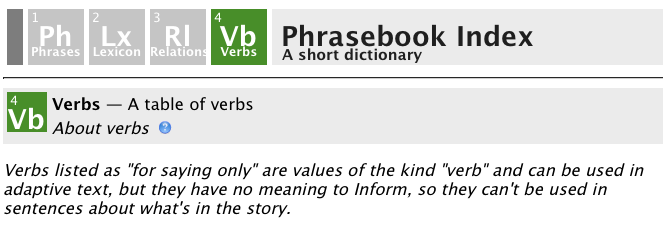As I have been going through the documentation again – I’m just finishing chapter 10 as of today – I have also been looking through the different parts of the Inform 7 Index so I can have an alternative view on the data and code I am testing. That way, I am also learning how to better utilize the Index in my coding process.
Many of the documentation sections have references to the appropriate part of the Index, but not all of them. Instead, there are documentation links in most of the Index sections that point back to relevant Document sections, like this:

The links are those little blue circles with the question marks in the middle.
I ran into a minor inconvenience in that the order of the Index sections and the order of the Documentation sections are significantly different from one another. For example, although Contents Index - 1. Contents is the first section of the Index, the Documentation section link About extensions links to Chapter 27: Extensions §27.1. The status of extensions.
So, I went through each section of the Index, grabbed all of the documentation links and sorted all the information by Documentation section order. If there wasn’t a link, I took my best guess. The result is a list of relevant Index sections for certain Documentation sections. Is there redundant information? Yes. But I still found it useful to read through a specific documentation section and then know where to go in the Index to see a different view on the coding and data concepts covered in the documentation. Hopefully, it will be useful for others as well:
Chapter 2: The Source Text §2.5. Headings
Contents Index - 1. Contents About headings
Chapter 2: The Source Text §2.12. Use Options
Contents Index - 5. Innards About use options
Chapter 2: The Source Text §2.13. Administering classroom use
Contents Index - 5. Innards - The following use options are in force:
Set from the Options.txt configuration file, or automatically
Chapter 2: The Source Text §2.14. Limits and the Settings panel
Contents Index - 5. Innards About the story file
Chapter 3: Things (the entire chapter)
World Index - 2. Gazetteer (no links, just seemed most relevant)
Chapter 3: Things §3.4. Regions and the index map
World Index - 1. Map (no links, just seemed most relevant)
Chapter 3: Things §3.5. Kinds
Kinds index - 1. Chart About kinds
Chapter 4: Kinds §4.1. New kinds
Kinds index - 1. Chart New kinds of objects
Chapter 4: Kinds §4.5. Kinds of value
Kinds index - 1. Chart Other new kinds
Chapter 4: Kinds §4.12. Values that vary
Kinds index - 3. Values About variables
Chapter 6: Descriptions §6.1. What are descriptions?
Phrasebook Index - 2. Lexicon About descriptions
Chapter 7: Basic Actions §7.1. Actions
Actions Index - 1. Grouped About actions
Actions Index - 2. Alphabetical About actions
Chapter 7: Basic Actions §7.15. Kind of actions
Actions Index - 3. Behaviors About kinds of actions
Chapter 9: Time §9.11. Future events
Scenes Index - 2. Events About timed events
Chapter 10: Scenes §10.1. Introduction to scenes
Scenes Index - 1. Plot About scenes
Chapter 10: Scenes §10.2. Creating a scene
Scenes Index - 3. Rules (no links, just seemed most relevant)
Chapter 10: Scenes §10.3 Using the Scene index
Scenes Index - 1. Plot No specific links
Chapter 10: Scenes §10.5. Linking scenes together
Scenes Index - 1. Plot How they link together
Chapter 11: Phrases §11.1. What are phrases?
Phrasebook Index - 1. Phrases About phrases
Chapter 12: Advanced Actions §12.4. Persuasion
Rules Index - 1. Standards - Rules governing actions
Chapter 12: Advanced Actions §12.5. Unsuccessful attempts
Rules Index - 1. Standards - Rules governing actions
Chapter 12: Advanced Actions §12.7. New actions
Actions Index - 1. Grouped New actions
Actions Index - 2. Alphabetical New actions
Chapter 12: Advanced Actions §12.10. Action variables
Actions Index - 1. Grouped New actions
Actions Index - 2. Alphabetical New actions
Chapter 12: Advanced Actions §12.15. Out of world actions
Actions Index - 1. Grouped Out of world actions (in red)
Actions Index - 2. Alphabetical Out of world actions (in red)
Chapter 13: Relations §13.1. Sentence verbs?
Phrasebook Index - 4. Verbs About verbs
Chapter 13: Relations §13.3. What are relations?
Phrasebook Index - 3. Relations About relations
Chapter 15: Numbers and Equations §15.20. Multiplication of units
Kinds index - 2. Arithmetic About arithmetic
Chapter 16: Tables §16.1. Laying out tables
Contents Index - 3. Tables About tables
Chapter 17: Understanding §17.1. Understand
Actions Index - 4. Commands About commands
Actions Index - 5. Tokens
"[anybody]"
"[anyone]"
"[somebody]"
"[someone]"
Chapter 17: Understanding §17.4. Standard tokens of grammar
Actions Index - 5. Tokens About tokens
"[anything]"
"[other things]"
"[something]"
"[something preferably held]"
"[things]"
"[things inside]"
"[things preferably held]"
Chapter 17: Understanding §17.5. The text token
Actions Index - 5. Tokens
"[text]"
Chapter 17: Understanding §17.13. New tokens
Actions Index - 5. Tokens New tokens
Chapter 18: Activities §18.1. What are activities?
Rules Index - 1. Standards About activities
Rules Index - 2. Extras About activities
Chapter 19: Rulebooks §19.1. On rules
Rules Index - 1. Standards About rulebooks
Rules Index - 2. Extras About rulebooks
Chapter 19: Rulebooks §19.4. Listing rules explicitly
Rules Index - 1. Standards Moving or abolishing rules
Rules Index - 2. Extras Moving or abolishing rules
Chapter 23: Figures, Sounds and Files §23.4. Gathering the figures
Contents Index - 4. Figures About figures
Chapter 23: Figures, Sounds and Files §23.7. Recorded sounds
Contents Index - 4. Figures About sounds
Chapter 23: Figures, Sounds and Files §23.11. Files
Contents Index - 4. Figures About files
Chapter 25: Releasing §25.4. The Library Card
Contents Index - 2. Card About the Library Card
Chapter 25: Releasing §25.5. The Treaty of Babel and the IFID
Contents Index - 2. Card About IFIDs
Chapter 27: Extensions §27.1. The status of extensions
Contents Index - 1. Contents About Extensions




